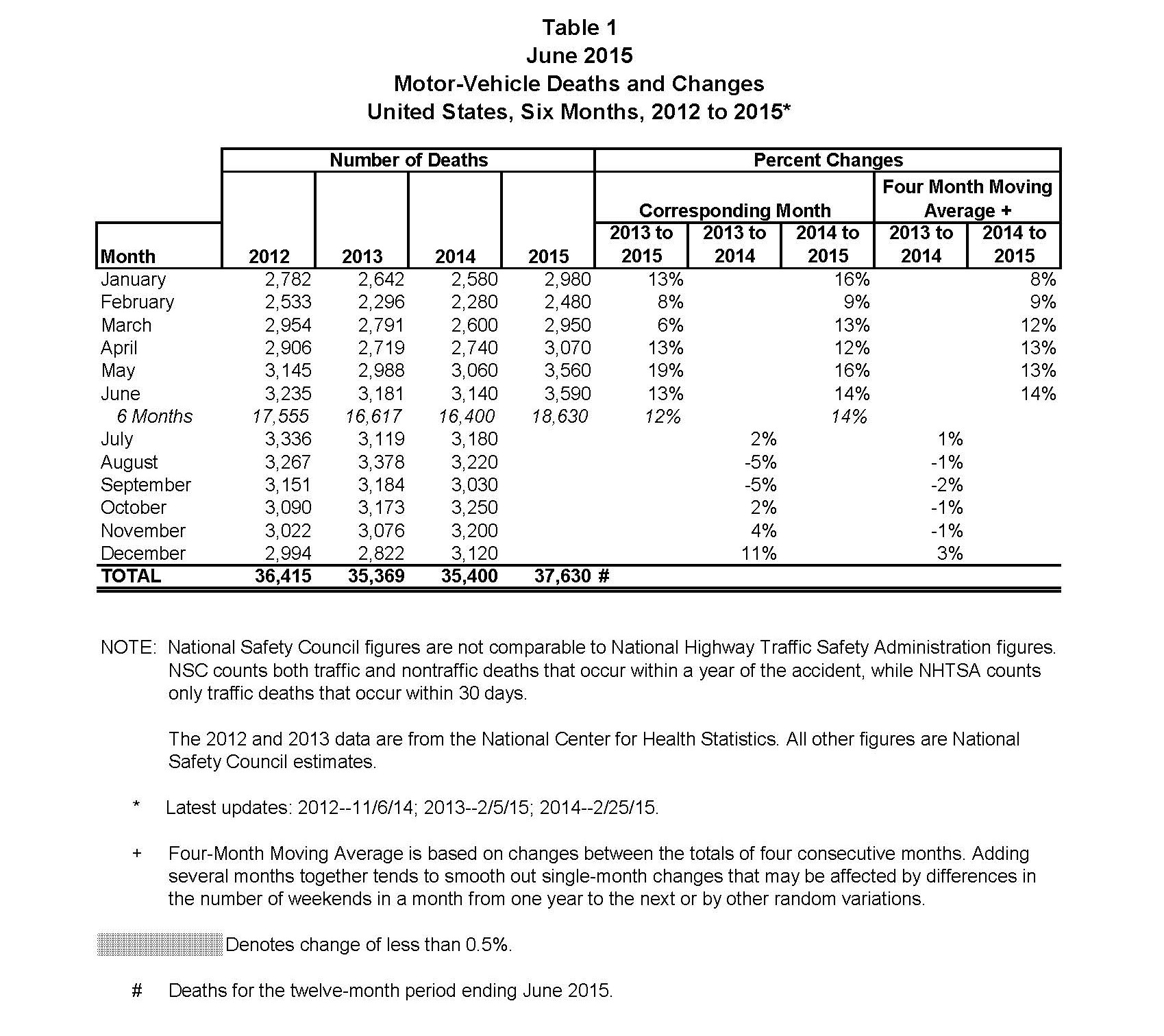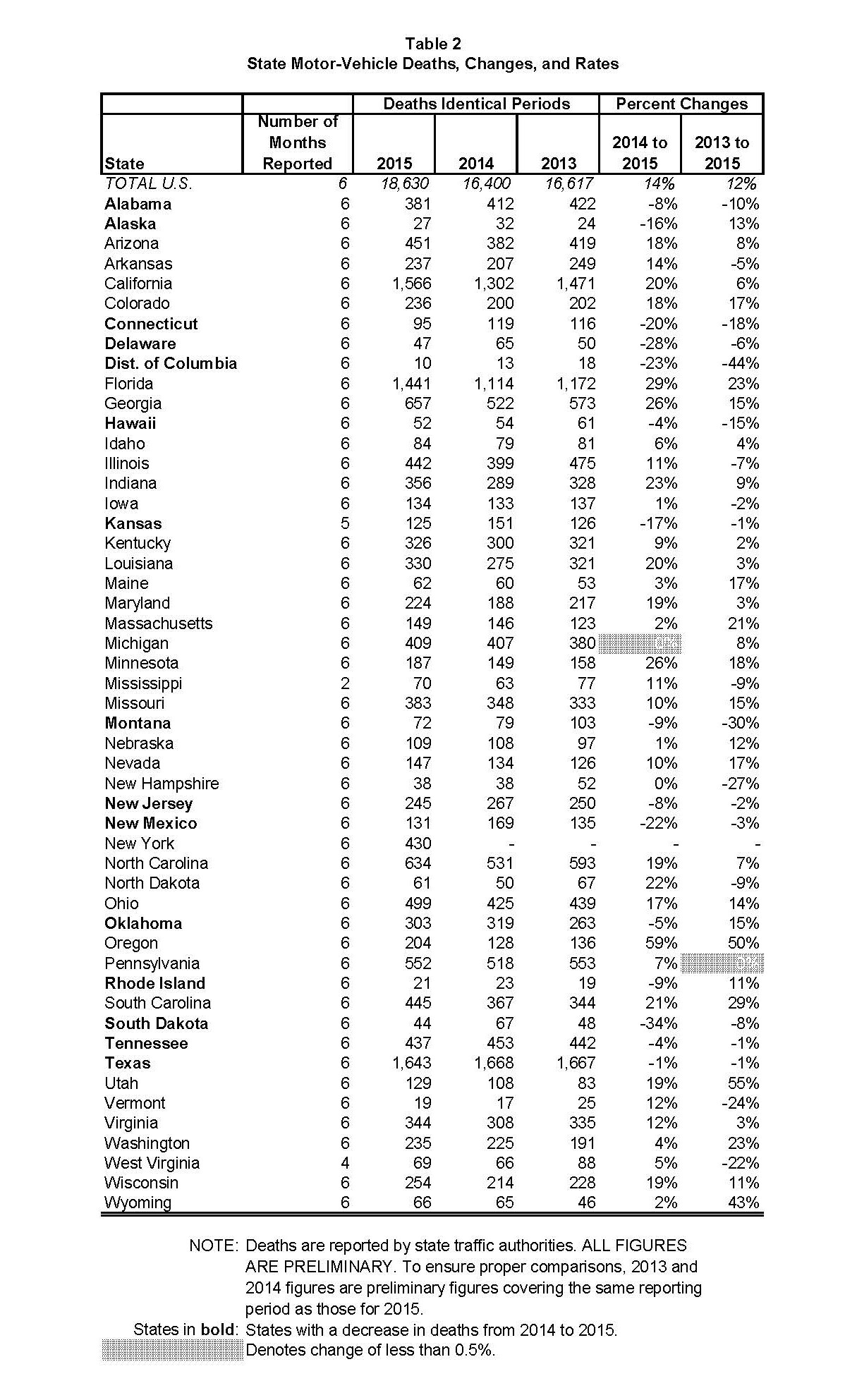
Traffic deaths and serious injuries substantially higher in first six months of 2015.
Monday, August 17, 2015. Itasca, IL – The National Safety Council estimates traffic deaths are 14 percent higher through the first six months of 2015 than they were during the same period in 2014, and serious injuries are 30 percent higher[i]. From January to June, nearly 19,000 people died in traffic crashes across the U.S., and more than 2.2 million were seriously injured[ii], putting the country on pace for its deadliest driving year since 2007.
Costs are also up. The six-month estimated bill for traffic deaths, injuries and property damage is $152 billion – 24 percent higher than 2014.
“Follow the numbers: the trend we are seeing on our roadways is like a flashing red light – danger lies ahead,” said Deborah A.P. Hersman, president and CEO of the National Safety Council. “Be a defensive driver and make safe decisions behind the wheel. Your life really depends on it.”
While the high death and injury toll could be due to many factors, an improving economy with lower gas prices and unemployment rates herald increases in vehicle miles traveled. Average gas prices are 30 percent lower than they were in 2014 and are projected to remain relatively stable heading into 2016[iii]. This generally means an increase in traffic; more people can afford to drive, and many travel longer distances and take vacations.
To help ensure safety, the Council recommends drivers:
- Make sure every passenger buckles up on every trip
- Designate an alcohol and drug-free driver or arranging alternate transportation
- Get plenty of sleep and taking regular breaks to avoid fatigue
- Never use a cell phone behind the wheel, even hands-free
- Stay engaged in teens’ driving habits. Teens are three times as likely to crash as more experienced drivers.
- Learn about your vehicle’s safety systems and how to use them. My Car Does What can help drivers understand the ins and outs of features such as adaptive cruise control, blind spot warning systems and backup cameras.
Supplemental traffic fatality estimates information
Motor-vehicle deaths up 14% in first six months of 2015. Motor-vehicle deaths for January through June of 2015 totaled 18,630. This figure is up 14% from the corresponding 6-month period in 2014. The June figure for 2015 was up 12% from the 2013 figure. The 6-month total for 2014 was 16,400, a 1% decrease from 2013. The 2013 figure was 5% lower than 2012. The estimated annual population death rate is 12.5 deaths per 100,000 population, up 13% from the preliminary 2014 rate of 11.1. The estimated annual mileage death rate is 1.3 deaths per 100 million vehicle miles traveled, up 8% from the preliminary 2014 rate of 1.2. If the level of increase in fatalities observed during the first two quarters were to remain through the end of the year, total motor-vehicle fatalities in 2015 could possibly exceed 40,000 for the first time in eight years.
The increase in fatalities in 2015 likely reflects the effects of the low real gas prices that have averaged 30% below 2014 levels over the first two quarters of 2015, helping to produce a 3.4% increase in cumulative vehicle mileage through May. It should be noted that gas prices and the economy are strongly connected and it is difficult to isolate the impact of lower gas prices from the overall impact of an improving economy.
Medically consulted motor-vehicle injuries for the first six months of 2015 are estimated to be about 2,254,000, an increase of 30% from 2014. Medically consulted injuries are not comparable to previous disabling injury estimates.
The estimated cost of motor-vehicle deaths, injuries, and property damage through June was $152.0 billion, a 24% increase from 2014. The costs include wage and productivity losses, medical expenses, administrative expenses, employer costs, and property damage.


About the National Safety Council
Founded in 1913 and chartered by Congress, the National Safety Council, nsc.org, is a nonprofit organization whose mission is to save lives by preventing injuries and deaths at work, in homes and communities, and on the road through leadership, research, education and advocacy. NSC advances this mission by partnering with businesses, government agencies, elected officials and the public in areas where we can make the most impact – distracted driving, teen driving, workplace safety, prescription drug overdoses and Safe Communities.
[i] According to NSC estimates. “Serious injuries” are classified as those requiring medical consultation.
[ii] According to NSC estimates. “Serious injuries” are classified as those requiring medical consultation.
[iii] According to Energy Information Administration
